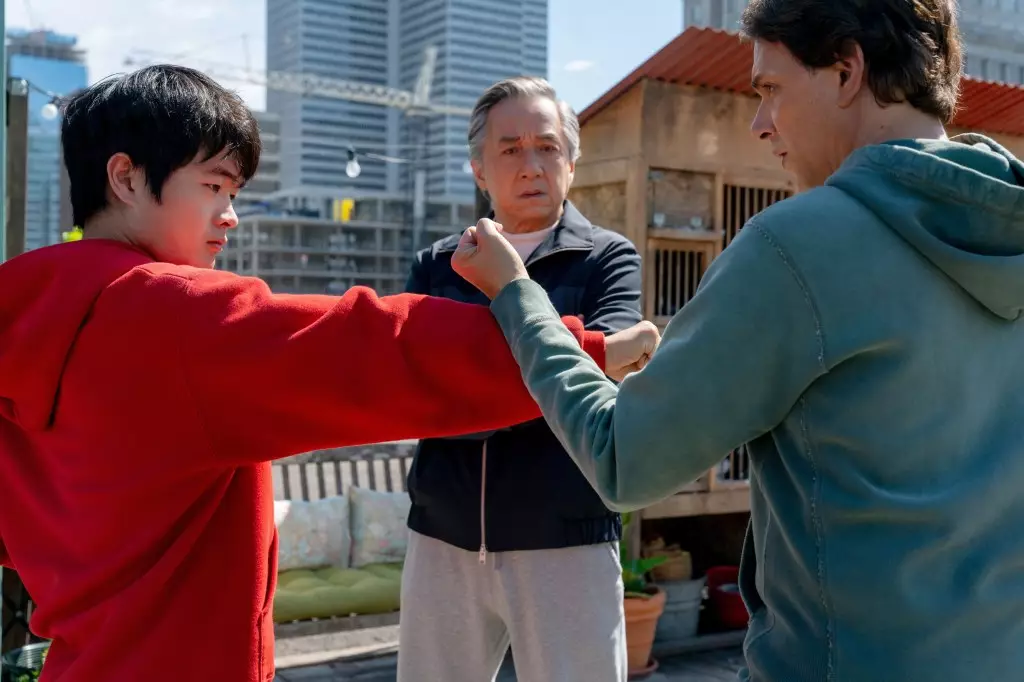Sony’s latest endeavor, *Karate Kid: Legends*, marks not just another sequel in a long-established franchise but a bold resurgence of a beloved series that has spanned over four decades. With a nostalgic nod to the original 1984 film, it offers a blend of seasoned characters like Ralph Macchio’s Daniel-san and Jackie Chan’s Mr. Han, while threading in elements of pop culture favorites like the *Cobra Kai* crew. This duality strikes a chord with both old-school fans and a younger audience, thus creating a cinematic experience that is accessible to several generations.
From its Thursday preview performance, which grossed $2.3 million starting at 2 p.m., it’s evident that anticipation surrounded the film. The box office forecast estimating between $25 million to $30 million for its opening weekend is promising, especially when placed alongside heavyweights like Disney’s reinvention of *Lilo & Stitch*, which is projected to capture an astonishing $60 million. This calls attention not only to the competition but also to the challenges that legacy films face in today’s market where families have numerous entertainment options.
Audience Reception: A Mixed Bag?
Critical reception, however, has been somewhat tepid. Currently sitting at 55% on Rotten Tomatoes as opposed to the 67% fresh score of the 2010 installment offers an intriguing discussion point about how audiences today are possibly re-evaluating nostalgic properties. Despite its long-standing legacy, perhaps audiences are fatigued with remakes and reboots, expecting innovation rather than a mere rehash. Yet, it’s noteworthy that *Karate Kid: Legends* earned a solid 4 stars from audience ratings on PostTrak, indicating a positive response from families and younger viewers. Specifically, kids under twelve responded with an impressive 79% “must-see right away” recommendation, showcasing the film’s potential to captivate the younger demographic.
In examining this audience reception, it becomes evident that while critics might be less than enthusiastic, the film’s true pulse lies in its collective experience shared among parents and children. With 60% of the audience being male and the age demographic of boys ages 10-12 accounting for a substantial portion, this reinforces the idea that the *Karate Kid* remains a seminal rite of passage for young males, much like it was in the past.
Understanding Box Office Dynamics
Sony invested $45 million in the production before marketing costs, which is notably $5 million more than what was spent on the 2010 remake, thus showing the studio’s commitment to revitalizing the series. With previous installments of the *Karate Kid* franchise grossing over $620 million globally, it raises the stakes significantly. The trend of revisiting classic films is not dismissed lightly here; instead, it reflects the inherent nostalgia that calls audiences back to the theaters.
However, the competitive landscape is also crucial. Coupled with blockbuster contenders like *Mission: Impossible – The Final Reckoning*, which is expected to maintain strong numbers based on its well-established franchise, *Karate Kid: Legends* faces the uphill task of establishing its own unique voice in a crowded market. Given that the initial $1.9 million from the *Garfield Movie* reboot in May serves as a benchmark, *Legends* has made a substantial leap already—pointing towards the potential longevity of its box office performance.
A Look at Other Contenders
Alongside *Karate Kid: Legends*, A24’s horror flick *Bring Her Back* is generating modest buzz. With $850K from previews and a positive reception, particularly among women over 25 who bestowed an 83% approval rating, it presents an interesting contrast to the family-friendly overtures of *Karate Kid*. Its male-heavy audience results lead to discussions about gender dynamics in film preference lately, revealing a telling split in film-going habits. This highlights the diverse tastes in cinema today, where a horror film can stand shoulder to shoulder with family-oriented content.
Meanwhile, the performance of *Lilo & Stitch* should not be overlooked. Despite trailing behind some earlier Disney adaptations like *Inside Out 2*, it still stands strong financially. Such statistics enforce the fact that the battle for the box office is not merely about brand recognition but also about modern storytelling that resonates with contemporary values and preferences.
It’s striking to consider how these films reflect broader societal trends and audience expectations. As they intertwine in this cinematic season, it is clear that the landscape is not dynamically static; beloved characters from the past vie for relevance, urging us to reflect on what nostalgia means in the world of modern filmmaking. The outcome of these projects may well dictate the direction of film franchises for years to come.

